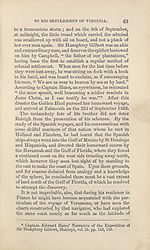Download files
Complete book:
Individual page:
Thumbnail gallery: Grid view | List view

42
from raleigh’s birth
The expedition, which set out under these happy
auspices, was unfortunate even in its commencement,
and ultimately fatal to its brave leader. In a short time
the Raleigh returned into harbour, a contagious dis¬
temper having broken out on hoard. Gilbert pursued
his voyage ; and having reached the Baccalaos, originally
discovered by John Cabot and sine* called Newfoundland,
took possession of it and the adjoining coasts in the name
of the English queen. The ceremony, although per¬
formed in the New World, was, according to the usages
of the Old, entirely feudal; the royal charter being first
read, and a rod and turf of the soil delivered to the
admiral. After a partial survey of the island, and an
interview with the natives, whose disposition was gentle
and pacific,* they steered towards the south, with the
intention of bringing the countries in that quarter under
“ the compass of the patent.” But discontent, mutiny,
and disease, broke out in the fleet; the Swallow was
sent home with the sick, and soon after the Delight was
completely wrecked. The remaining barks were the
Golden Hind and Squirrel; the first of forty, the last of
ten tons burden. For what reason does not appear, the
admiral insisted, against the remonstrances of his officers
and crew, in having his flag in the Squirrel. It was a
fatal resolution : the weather soon after became dark
and lowering, the sailors with characteristic superstition
declared they heard strange voices commanding them to
leave the helm ; fearful shapes were said to glare during
the night around the ship, and the apparition of the
ominous flame, called by seamen “ Castor and Pollux,”
flitted above the mast.t These portents were the preludes
letter explains this difference. When Sir Humphrey was at
Plymouth on the eve of sailing, the queen commands him, we
sec, to leave his picture with Raleigh. This must allude to a
portrait already painted; and of course the golden anchor then
sent could not be ■seen in it. Now he perished on the voyage.
The picture at Devonshire House mentioned by Granger, which
bears this honourable badge, must therefore have been painted
after his death.
* Hakluyt, vol. iii. pp. 151,153. + Ibid. pp. 156, 158, 159.
from raleigh’s birth
The expedition, which set out under these happy
auspices, was unfortunate even in its commencement,
and ultimately fatal to its brave leader. In a short time
the Raleigh returned into harbour, a contagious dis¬
temper having broken out on hoard. Gilbert pursued
his voyage ; and having reached the Baccalaos, originally
discovered by John Cabot and sine* called Newfoundland,
took possession of it and the adjoining coasts in the name
of the English queen. The ceremony, although per¬
formed in the New World, was, according to the usages
of the Old, entirely feudal; the royal charter being first
read, and a rod and turf of the soil delivered to the
admiral. After a partial survey of the island, and an
interview with the natives, whose disposition was gentle
and pacific,* they steered towards the south, with the
intention of bringing the countries in that quarter under
“ the compass of the patent.” But discontent, mutiny,
and disease, broke out in the fleet; the Swallow was
sent home with the sick, and soon after the Delight was
completely wrecked. The remaining barks were the
Golden Hind and Squirrel; the first of forty, the last of
ten tons burden. For what reason does not appear, the
admiral insisted, against the remonstrances of his officers
and crew, in having his flag in the Squirrel. It was a
fatal resolution : the weather soon after became dark
and lowering, the sailors with characteristic superstition
declared they heard strange voices commanding them to
leave the helm ; fearful shapes were said to glare during
the night around the ship, and the apparition of the
ominous flame, called by seamen “ Castor and Pollux,”
flitted above the mast.t These portents were the preludes
letter explains this difference. When Sir Humphrey was at
Plymouth on the eve of sailing, the queen commands him, we
sec, to leave his picture with Raleigh. This must allude to a
portrait already painted; and of course the golden anchor then
sent could not be ■seen in it. Now he perished on the voyage.
The picture at Devonshire House mentioned by Granger, which
bears this honourable badge, must therefore have been painted
after his death.
* Hakluyt, vol. iii. pp. 151,153. + Ibid. pp. 156, 158, 159.
Set display mode to:
![]() Universal Viewer |
Universal Viewer | ![]() Mirador |
Large image | Transcription
Mirador |
Large image | Transcription
| Antiquarian books of Scotland > Politics & government > Life of Sir Walter Raleigh > (48) |
|---|
| Permanent URL | https://digital.nls.uk/113652980 |
|---|
| Description | Thousands of printed books from the Antiquarian Books of Scotland collection which dates from 1641 to the 1980s. The collection consists of 14,800 books which were published in Scotland or have a Scottish connection, e.g. through the author, printer or owner. Subjects covered include sport, education, diseases, adventure, occupations, Jacobites, politics and religion. Among the 29 languages represented are English, Gaelic, Italian, French, Russian and Swedish. |
|---|

